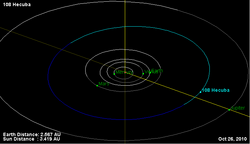Astronomy:108 Hecuba
 Orbital diagram | |||||||||||||
| Discovery | |||||||||||||
|---|---|---|---|---|---|---|---|---|---|---|---|---|---|
| Discovered by | R. Luther | ||||||||||||
| Discovery date | 2 April 1869 | ||||||||||||
| Designations | |||||||||||||
| (108) Hecuba | |||||||||||||
| Pronunciation | /ˈhɛkjʊbə/[1] | ||||||||||||
| Named after | Hecuba | ||||||||||||
| Minor planet category | Main belt | ||||||||||||
| Orbital characteristics[2] | |||||||||||||
| Epoch 31 July 2016 (JD 2457600.5) | |||||||||||||
| Uncertainty parameter 0 | |||||||||||||
| Observation arc | 135.87 yr (49628 d) | ||||||||||||
| |{{{apsis}}}|helion}} | 3.4190 astronomical unit|AU (511.48 Gm) | ||||||||||||
| |{{{apsis}}}|helion}} | 3.05922 AU (457.653 Gm) | ||||||||||||
| 3.23912 AU (484.565 Gm) | |||||||||||||
| Eccentricity | 0.055539 | ||||||||||||
| Orbital period | 5.83 yr (2129.3 d) | ||||||||||||
| Average Orbital speed | 16.53 km/s | ||||||||||||
| Mean anomaly | 166.649° | ||||||||||||
| Mean motion | 0° 10m 8.648s / day | ||||||||||||
| Inclination | 4.2204° | ||||||||||||
| Longitude of ascending node | 350.014° | ||||||||||||
| 204.634° | |||||||||||||
| Earth MOID | 2.05833 AU (307.922 Gm) | ||||||||||||
| Jupiter MOID | 1.55152 AU (232.104 Gm) | ||||||||||||
| TJupiter | 3.178 | ||||||||||||
| Physical characteristics | |||||||||||||
| Dimensions | 64.97±4.4 km[2] 65 km[3] | ||||||||||||
| Mass | ~3.9×1017 kg (estimate) | ||||||||||||
| Mean density | ~2.7 g/cm3 (estimate)[4] | ||||||||||||
Equatorial surface gravity | ~0.025 m/s² (estimate) | ||||||||||||
Equatorial escape velocity | ~0.040 km/s (estimate) | ||||||||||||
| Rotation period | 14.256 h (0.5940 d)[2] 0.60 d or 1.20 d[5] | ||||||||||||
| Geometric albedo | 0.2431±0.037 | ||||||||||||
| |||||||||||||
| S[6] | |||||||||||||
| Absolute magnitude (H) | 8.09 | ||||||||||||
Hecuba (minor planet designation: 108 Hecuba) is a fairly large and bright main-belt asteroid. It was discovered by Karl Theodor Robert Luther on 2 April 1869,[7] and named after Hecuba, wife of King Priam in the legends of the Trojan War in Greek Mythology. This object is orbiting the Sun with a period of 5.83 years and an eccentricity of 0.06. It became the first asteroid discovered to orbit near a 2:1 mean-motion resonance with the planet Jupiter,[8] and is the namesake of the Hecuba group of asteroids.[9]
In the Tholen classification system, it is categorized as a stony S-type asteroid,[10] while the Bus asteroid taxonomy system lists it as an Sw asteroid.[11] Observations performed at the Palmer Divide Observatory in Colorado Springs, Colorado in during 2007 produced a light curve with a period of 17.859 ± 0.005 hours with a brightness variation of 0.11 ± 0.02 in magnitude.[12]
Hecuba orbits within the Hygiea family of asteroids but is not otherwise related to other family members because it has a silicate composition; Hygieas are dark C-type asteroids.[citation needed]
References
- ↑ "Hecuba". Dictionary.com Unabridged. Random House. https://www.dictionary.com/browse/Hecuba.
- ↑ 2.0 2.1 2.2 Yeomans, Donald K., "108 Hecuba", JPL Small-Body Database Browser (NASA Jet Propulsion Laboratory), https://ssd.jpl.nasa.gov/sbdb.cgi?sstr=108, retrieved 12 May 2016.
- ↑ "IRAS Minor Planet Survey (IMPS)". Archived from the original on 2005-12-22. https://archive.today/20051222220311/http://www.psi.edu/pds/archive/simps.html. Retrieved 2005-12-11.
- ↑ Krasinsky, G. A. et al. (July 2002), "Hidden Mass in the Asteroid Belt", Icarus 158 (1): 98–105, doi:10.1006/icar.2002.6837, Bibcode: 2002Icar..158...98K. See appendix A.
- ↑ Harris, A.W.; Warner, B.D.; Pravec, P., eds. (2012), "Lightcurve Derived Data", Planetary Data System (NASA), http://sbn.psi.edu/pds/resource/lc.html, retrieved 2013-03-22.
- ↑ DeMeo, Francesca E. et al. (2011), "An extension of the Bus asteroid taxonomy into the near-infrared", Icarus 202 (1): 160–180, doi:10.1016/j.icarus.2009.02.005, Bibcode: 2009Icar..202..160D, archived from the original on 2014-03-17, https://web.archive.org/web/20140317200310/https://www.tara.tcd.ie/bitstream/2262/43276/1/PEER_stage2_10.1016/j.icarus.2009.02.005.pdf. See appendix A.
- ↑ "Numbered Minor Planets 1–5000", Discovery Circumstances (IAU Minor Planet center), https://www.minorplanetcenter.net/iau/lists/NumberedMPs000001.html, retrieved 2013-04-07.
- ↑ Brož, M.; Vokrouhlický, D.; Roig, F.; Nesvorný, D.; Bottke, W. F.; Morbidelli, A. (June 2005), "Yarkovsky origin of the unstable asteroids in the 2/1 mean motion resonance with Jupiter", Monthly Notices of the Royal Astronomical Society 359 (4): 1437–1455, doi:10.1111/j.1365-2966.2005.08995.x, Bibcode: 2005MNRAS.359.1437B, https://hal.archives-ouvertes.fr/hal-00388251/file/359-4-1437.pdf.
- ↑ McDonald, Sophia Levy (June 1948), "General perturbations and mean elements, with representations of 35 minor planets of the Hecuba group", Astronomical Journal 53: 199, doi:10.1086/106097, Bibcode: 1948AJ.....53..199M, http://adsabs.harvard.edu/cgi-bin/nph-data_query?bibcode=1948AJ.....53..199M&link_type=ARTICLE&db_key=AST&high=.
- ↑ Blanco, C. et al. (1994), Kozai, Yoshihide; Binzel, Richard P.; Hirayama, Tomohiro, eds., "A Physical Study of the Asteroid 108 Hecuba", Seventy-five (75) years of Hirayama asteroid families: The role of collisions in the solar system history; Proceedings of the international conference; held November 29-December 3; 1993 at the Institute of Space and Astronautical Science (ISAS) at Sagamihara near Tokyo; Japan, Astronomical Society of the Pacific Conference (San Francisco: Astronomical Society of the Pacific) 63: p. 280, Bibcode: 1994ASPC...63..280B
- ↑ DeMeo, Francesca E. et al. (July 2009), "An extension of the Bus asteroid taxonomy into the near-infrared", Icarus 202 (1): 160–180, doi:10.1016/j.icarus.2009.02.005, Bibcode: 2009Icar..202..160D, archived from the original on 2014-03-17, https://web.archive.org/web/20140317200310/https://www.tara.tcd.ie/bitstream/2262/43276/1/PEER_stage2_10.1016/j.icarus.2009.02.005.pdf, retrieved 2013-04-08. See appendix A.
- ↑ Warner, Brian D. (September 2007), "Asteroid Lightcurve Analysis at the Palmer Divide Observatory", The Minor Planet Bulletin 34 (3): 72, Bibcode: 2007MPBu...34...72W.
External links
- Lightcurve plot of 108 Hecuba, Palmer Divide Observatory, B. D. Warner (2007)
- Asteroid Lightcurve Database (LCDB), query form (info )
- Dictionary of Minor Planet Names, Google books
- Asteroids and comets rotation curves, CdR – Observatoire de Genève, Raoul Behrend
- Discovery Circumstances: Numbered Minor Planets (1)-(5000) – Minor Planet Center
- 108 Hecuba at AstDyS-2, Asteroids—Dynamic Site
- 108 Hecuba at the JPL Small-Body Database
 |

